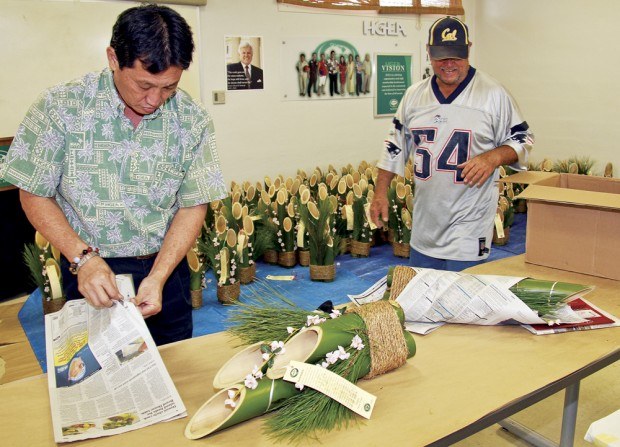LIHU‘E — Kadomatsu, one of the more familiar New Year’s decorations, are now on sale at the Hawai‘i Government Employees Association offices on Aikahi Street in Lihu‘e. It has been more than a century since the first Japanese immigrants arrived
LIHU‘E — Kadomatsu, one of the more familiar New Year’s decorations, are now on sale at the Hawai‘i Government Employees Association offices on Aikahi Street in Lihu‘e.
It has been more than a century since the first Japanese immigrants arrived in Hawai‘i to work in the plantations, but the tradition of New Year’s continues as HGEA workers were joined by Neal Wagatsuma’s crew to create about 350 of the popular decoration for homes and offices.
The tradition, passed on from generation to generation, utilizes plant forms readily available in Hawai‘i, and continues as part of the holiday celebration.
Earl Miyao, a longtime HGEA volunteer with the project, said they started gathering bamboo, one of the three central elements of kadomatsu, on Wednesday from property owned by Grove Farm.
Thursday and Friday were spent cutting and cleaning the harvested bamboo so it could be assembled into its final kadomatsu, Saturday.
“Christmas falls on Sunday, this year,” Miyao said. “That means New Year’s is also on Sunday so we have to start early.”
Gerald Ako, the HGEA Kaua‘i director, said people can simply come to the offices during the week from 7:30 a.m. to 4:30 p.m. to pick up their kadomatsu while supplies last.
“If get, get; if no mo’, then no mo’,” said Ako, who along with Dale Shimomura and Tommy Rita were packing kadomatsu for shipment to O‘ahu and Maui. He said the proceeds will benefit the Charles Kendall and Russell Okata scholarship fund.
Kadomatsu translates to “gate pine,” according to LovetoKnow.com. Placing the kadomatsu at a building’s entry until Jan. 7 it is believed to welcome the ancestral spirits of the harvest.
The three elements forming the heart of the kadomatsu are bamboo, pine and ume or plum tree sprigs, each symbolizing longevity, loyalty and prosperity.
The information card accompanying the HGEA kadomatsu states the pine, bamboo and plum blossoms symbolize longevity, gentleness and fidelity, the origin of the custom residing in the belief that kadomatsu serve as a dwelling place for the god who brings good luck at the beginning of the year.
Each of the three shoots that form the core are cut to different heights, symbolizing heaven, humanity and earth, and tied with new straw rope. The pine, as an evergreen, symbolizes constancy while the bamboo, which can be bent without breaking, symbolizes resilience.
New Year celebrations, or oshogatsu, is a very important holiday for the Japanese people, states the website of American School in Japan. Its fifth-grade students said in the Shinto tradition, homes are thoroughly cleaned before the New Year and special food, or osechi ryori, is prepared in the days before Jan. 1 so everyone can enjoy New Year’s Day together.
Locally, Ed Kawamura of M. Kawamura Enterprises, said since Christmas falls on Sunday and the holiday is observed Monday, his family will gather to make mochi, one of the popular New Year’s foods, on Monday.
The mochi is also used for one of the New Year’s decorations, where two large mochi are placed on top of each other with a tangerine, or mikan, placed on top. Following the New Year, the whole family participates in eating the mochi and orange, the ASIJ fifth graders said.
Elvrine Chow, a vendor at the Kaua‘i Community Market, said she will have kadomatsu for sale Saturday.
• Dennis Fujimoto, photographer and staff writer, can be reached at 245-3681 (ext. 253) or dfujimoto@ thegardenisland.com.


